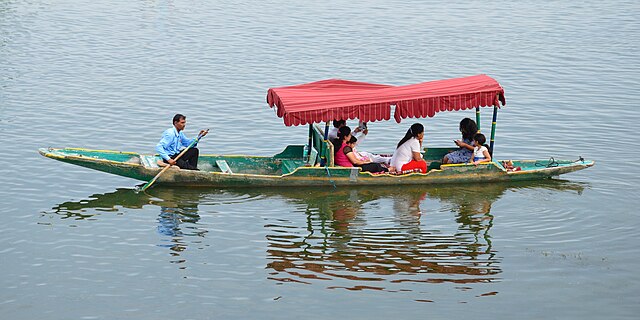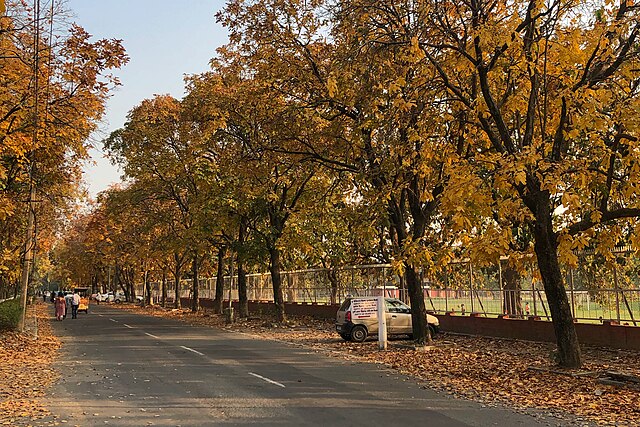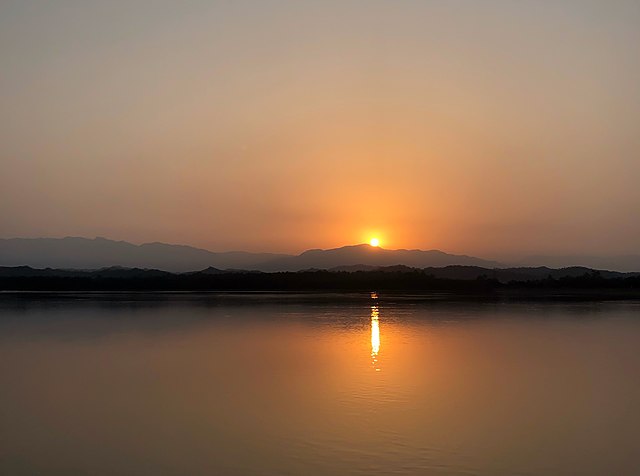Have you ever wondered what makes Chandigarh’s weather so unique? Nestled at the foothills of the Shivalik range, this planned city experiences a fascinating blend of climatic conditions that set it apart from other Indian metropolises. Whether you’re planning a visit or considering making Chandigarh your home, understanding its weather patterns is crucial for making the most of your time in this beautiful city.
Chandigarh’s weather story isn’t just about temperatures and rainfall – it’s about how geography, urban planning, and natural forces come together to create a climate that’s both challenging and delightful. From scorching summers that test your endurance to pleasant winters that make you want to stay outdoors all day, Chandigarh offers a complete weather experience.
What Makes Chandigarh’s Climate Special?
Chandigarh enjoys a subtropical continental climate that’s characterized by distinct seasonal variations. Unlike coastal cities with their moderating sea breezes, or hill stations with their consistently cool temperatures, Chandigarh experiences the full spectrum of North Indian weather patterns. The city sits at an elevation of approximately 321 meters above sea level, which plays a significant role in shaping its climate.
What’s particularly interesting about Chandigarh’s weather is how Le Corbusier’s urban planning philosophy considered climatic factors. The city’s grid system, green belts, and open spaces were designed to work with, rather than against, the natural weather patterns. This thoughtful planning has created microclimates within the city that can make a real difference to your daily comfort.
The city experiences three main seasons – summer, monsoon, and winter – with brief transitional periods that locals often refer to as spring and post-monsoon. Each season brings its own character, challenges, and beauty to this carefully planned metropolis.
The Four Seasons of Chandigarh

Spring in Chandigarh (March – April)
Spring in Chandigarh is like nature’s gentle wake-up call after the winter slumber. The weather during these months is absolutely delightful, with temperatures ranging from 15°C to 25°C. This is when the city truly lives up to its nickname “City Beautiful” – flowers bloom in the famous Rose Garden, trees regain their lush green color, and the air carries a freshness that’s hard to describe.
During spring, you’ll notice the days getting longer and warmer, but the heat hasn’t yet reached the intensity of summer. Morning walks in the Rock Garden become pure joy, and evening strolls in Sukhna Lake are nothing short of magical. The weather is perfect for outdoor activities, and you’ll see locals making the most of this pleasant period.
However, spring can be unpredictable. One day might be perfectly pleasant, and the next could bring unexpected showers or a sudden temperature spike. This variability keeps life interesting but requires you to be prepared for quick weather changes.
Summer Season: When the Heat Takes Over (May – June)
Summer in Chandigarh is not for the faint-hearted. From May through June, temperatures can soar to 45°C or even higher during extreme heat waves. The sun becomes a formidable force, and the concrete jungle effect of urban development amplifies the heat, making afternoons almost unbearable.
But here’s the thing about Chandigarh summers – they’re dry. Unlike humid coastal cities where you feel sticky and uncomfortable, Chandigarh’s heat is intense but relatively dry. This makes it more bearable once you adapt and learn to time your activities appropriately.
The saving grace during summer months is the evening relief. As the sun sets, temperatures drop significantly, and the planned green spaces of Chandigarh provide natural cooling. The city’s numerous parks and tree-lined streets become evening refuges where families gather and children play.
Air conditioning becomes a necessity rather than a luxury during peak summer. Most residents plan their daily routines around avoiding the midday heat, with early morning and late evening being the preferred times for outdoor activities.
Monsoon Magic: Chandigarh’s Rainy Season (July – September)
When the monsoons arrive in Chandigarh, they bring more than just rain – they bring relief, renewal, and sometimes chaos. The monsoon season typically begins in late June or early July and continues through September, bringing much-needed respite from the scorching summer heat.
Chandigarh receives an average annual rainfall of about 1100mm, with most of it concentrated during these monsoon months. The rain transforms the city dramatically – dust settles, temperatures drop to a comfortable 25-30°C, and the entire landscape turns various shades of green.
However, monsoons in Chandigarh can be quite intense. Heavy downpours can lead to waterlogging in certain areas, and the city’s drainage system sometimes struggles to cope with sudden heavy rainfall. The Sukhna Lake fills up beautifully during this time, creating picture-perfect scenes that attract photographers from across the region.
The monsoon period also brings its challenges – increased humidity, occasional flooding in low-lying areas, and the need for constant vigilance about weather forecasts. But for most residents, the monsoon months are a welcome break from the summer heat.
Winter Wonderland: Chandigarh’s Cool Months (October – February)
Winter is when Chandigarh truly shines. From October through February, the city experiences its most pleasant weather, with temperatures ranging from 5°C to 20°C. This is peak tourist season, and for good reason – the weather is absolutely perfect for exploring everything the city has to offer.
December and January can get quite cold, especially during the night, with temperatures sometimes dropping to 2-3°C. The mornings often bring dense fog that can affect visibility and transportation, but once it clears, you’re left with bright, sunny days that are perfect for outdoor activities.
Winter in Chandigarh means clear blue skies, crisp air, and comfortable temperatures that make you want to spend all your time outdoors. The Rock Garden looks stunning under the winter sun, Sukhna Lake becomes a hub of activity, and the city’s many parks and gardens are at their most inviting.
Monthly Weather Breakdown

January to March: The Cool Beginning
January starts the year with Chandigarh at its coldest. Morning temperatures can drop to 3-5°C, while afternoons warm up to a comfortable 18-20°C. Fog is common during early morning hours, often affecting flight schedules and road travel. Despite the cold, January weather is generally pleasant with clear skies and minimal rainfall.
February continues the winter pattern but with gradually warming temperatures. Morning fog becomes less frequent, and you’ll notice longer daylight hours. This is an excellent time for sightseeing and outdoor activities, as the weather remains comfortable throughout the day.
March marks the beginning of the transition to warmer weather. Temperatures start rising, ranging from 10°C in the morning to 25°C in the afternoon. The weather remains pleasant, but you can sense summer approaching. This is when locals start shedding their heavy winter clothing and begin preparing for the heat ahead.
April to June: Rising Temperatures
April is still manageable, with temperatures ranging from 15°C to 30°C. The weather is warm but not yet extreme, making it a decent time for travel if you can handle moderate heat. However, by the end of April, you’ll definitely feel summer approaching.
May is when Chandigarh’s summer truly begins. Temperatures regularly cross 35°C, and on particularly hot days, they can reach 40°C or higher. The heat becomes intense, especially during midday hours. Air conditioners start working overtime, and people begin adjusting their daily routines to avoid peak heat hours.
June is typically the hottest month in Chandigarh. Maximum temperatures can reach 44-45°C, making outdoor activities challenging during daylight hours. However, June also marks the anticipation of monsoons, with occasional pre-monsoon showers providing temporary relief.
July to September: Monsoon Months
July brings the much-awaited monsoon rains. The first showers are celebrated as they bring immediate relief from the summer heat. Temperatures drop to a more comfortable 25-32°C range, but humidity increases significantly. The rainfall can be heavy and sudden, sometimes causing temporary flooding in certain areas.
August continues the monsoon pattern with regular rainfall and pleasant temperatures. This is when Chandigarh looks its greenest, with parks and gardens flourishing. However, the increased humidity can make the weather feel more oppressive than the actual temperature suggests.
September marks the end of the monsoon season. Rainfall decreases, but the weather remains humid. Temperatures stay in the comfortable range of 24-30°C, and the city begins to dry out as it prepares for the post-monsoon period.
October to December: Pleasant Weather Returns
October is a transition month when the monsoons retreat and the weather becomes increasingly pleasant. Temperatures range from 18°C to 28°C, humidity decreases, and the skies clear up. This is when many consider Chandigarh to be at its most beautiful – the post-monsoon freshness combined with comfortable temperatures.
November brings the onset of winter with temperatures dropping to 12-24°C. The weather is absolutely delightful, with clear skies, comfortable temperatures, and low humidity. This is peak tourist season, and outdoor activities become enjoyable once again.
December ushers in proper winter weather with temperatures ranging from 8°C to 20°C. Morning fog becomes more common, and you’ll need warm clothing for early morning and evening hours. Despite the cold, the weather remains pleasant and sunny during the day.
How Chandigarh’s Location Affects Its Weather
The Role of Shivalik Hills
The Shivalik hills play a crucial role in shaping Chandigarh’s weather patterns. These hills act as a natural barrier that influences wind patterns, rainfall distribution, and temperature variations. During winter, cold winds from the north are partially blocked by these hills, preventing extreme cold conditions that affect higher altitude areas.
The hills also influence the monsoon patterns. They help in the orographic lifting of moisture-laden winds, contributing to the rainfall that Chandigarh receives. This geographical feature ensures that the city gets adequate rainfall during the monsoon season while also providing some protection from extreme weather events.
Urban Heat Island Effect
As Chandigarh has grown and urbanized, it has begun experiencing the urban heat island effect. This phenomenon causes the city to be warmer than its surrounding rural areas, especially during summer months. The concrete structures, roads, and reduced green cover in some areas contribute to heat retention, making summers feel more intense than they might in less developed areas.
However, Chandigarh’s original planning with extensive green belts and open spaces helps mitigate this effect to some extent. The city’s planners were forward-thinking in their approach to maintaining green spaces, which continue to provide natural cooling and help regulate the local climate.
Weather Patterns and Climate Change Impact

Extreme Weather Events in Chandigarh
Climate change has brought noticeable changes to Chandigarh’s weather patterns. Extreme weather events have become more frequent and intense. Heat waves during summer are more severe, with temperatures reaching record highs. Unseasonal rainfall has also become more common, disrupting traditional weather patterns.
Recent years have seen sudden thunderstorms with strong winds causing damage to trees and infrastructure. These events, while not entirely new, have increased in frequency and intensity. The city has had to adapt its preparedness strategies to deal with these changing weather patterns.
Long-term Climate Trends
Over the past few decades, Chandigarh has experienced gradual changes in its climate patterns. Summers are getting hotter and lasting longer, while winters are becoming milder. The monsoon season shows variability – some years bring excessive rainfall leading to flooding, while others see deficient rainfall causing water scarcity concerns.
These long-term trends have implications for urban planning, agriculture in surrounding areas, and daily life in the city. The administration has begun incorporating climate resilience into city planning and infrastructure development.
Best Time to Visit Chandigarh
Tourist Season Recommendations
If you’re planning to visit Chandigarh, timing your trip according to the weather can make or break your experience. The absolute best time to visit is from October to March when the weather is most pleasant. During this period, you can comfortably explore all outdoor attractions without worrying about extreme heat or heavy rainfall.
November to February is particularly recommended for tourists who want to experience Chandigarh at its best. The weather is cool and comfortable, perfect for sightseeing, outdoor dining, and enjoying the city’s famous gardens and parks. Hotel rates might be slightly higher during this peak season, but the pleasant weather more than compensates for the extra cost.
For budget travelers who don’t mind some heat, April and early May can be good options. The weather is warm but still manageable, and you’ll find better deals on accommodation. However, avoid May and June unless you’re specifically prepared for intense heat.
Weather-Based Activity Planning
Different seasons in Chandigarh are suited for different activities. Winter months are perfect for exploring outdoor attractions like the Rock Garden, Rose Garden, and Sukhna Lake. The pleasant weather makes walking tours enjoyable, and outdoor dining becomes a delightful experience.
Monsoon season, while challenging for some outdoor activities, offers its own charm. The city looks lush and green, and if you don’t mind occasional showers, it can be a romantic time to visit. Just be prepared with appropriate rain gear and flexible planning.
Summer months are best avoided for extensive outdoor activities, but they’re perfect for exploring indoor attractions like museums, shopping centers, and experiencing the local food scene in air-conditioned comfort.
Preparing for Chandigarh Weather
What to Pack for Different Seasons
Packing for Chandigarh requires careful consideration of the season you’re visiting. For winter visits (November to February), pack warm clothing including sweaters, jackets, and scarves. Mornings and evenings can be quite cold, so layering is key. Don’t forget comfortable walking shoes as this is the best time for exploring the city on foot.
Summer visits (April to June) require light, breathable cotton clothing, sun hats, sunglasses, and strong sunscreen. Carry water bottles and plan for air-conditioned accommodations. Light-colored clothing helps reflect heat and keeps you cooler.
Monsoon season (July to September) calls for waterproof clothing, umbrellas, and quick-dry fabrics. Waterproof footwear is essential as streets can get waterlogged. Pack clothes that dry quickly and don’t mind getting wet.
Weather Apps and Resources
Staying updated with Chandigarh’s weather is crucial for planning your daily activities. Several reliable weather apps provide accurate local forecasts. The India Meteorological Department (IMD) offers official weather updates and warnings for extreme weather events.
Local news channels and newspapers also provide daily weather updates with specific focus on local conditions. Many residents rely on these sources for planning their day, especially during monsoon season when weather can change rapidly.
Local Weather Phenomena
Fog and Visibility Issues
One of Chandigarh’s most notable weather phenomena is the dense fog that occurs during winter months, particularly in December and January. This fog can be so thick that visibility drops to just a few meters, significantly affecting air and road travel. The fog typically forms during early morning hours and can persist until late morning.
The fog is caused by the combination of moisture in the air, calm wind conditions, and the radiative cooling that occurs during clear winter nights. While it creates beautiful, ethereal scenes across the city, it also poses challenges for transportation and daily activities.
Dust Storms and Air Quality
Pre-monsoon months (April to June) sometimes bring dust storms to Chandigarh. These storms, originating from Rajasthan and other arid regions, can significantly reduce air quality and visibility. While not as severe as in Delhi or other NCR cities, these dust storms can cause discomfort and health issues for sensitive individuals.
The city’s relatively good green cover helps in filtering air pollution to some extent, but during dust storms, it’s advisable to stay indoors and use air purifiers if available.
Impact of Weather on Daily Life
Agriculture and Weather
While Chandigarh itself is an urban center, the surrounding areas are heavily agricultural, and weather patterns significantly impact farming activities. The monsoon season is crucial for crop cultivation, and variations in rainfall directly affect agricultural output in the region.
Many residents of Chandigarh have connections to agricultural communities in surrounding areas, so weather patterns that affect farming also impact the city’s economy and food supply chains.
Transportation and Weather Challenges
Weather significantly impacts transportation in Chandigarh. Dense winter fog can disrupt flight schedules at the Chandigarh Airport and affect road travel. During heavy monsoon rains, some roads may experience waterlogging, causing traffic delays.
Summer heat can make waiting for public transportation uncomfortable, leading to increased reliance on private vehicles and air-conditioned transport options. The city’s infrastructure has adapted to these weather challenges, but they remain a part of daily life that residents must navigate.
Conclusion
Chandigarh’s weather is a story of extremes and beauty, challenges and delights. From the scorching summers that test your resilience to the pleasant winters that make you fall in love with the city, each season brings its own character to this planned metropolis. Understanding these weather patterns isn’t just about knowing when to carry an umbrella or wear a sweater – it’s about appreciating how climate shapes the rhythm of life in India’s City Beautiful.
The key to enjoying Chandigarh’s weather is adaptation and preparation. Embrace the monsoons with their dramatic downpours and lush greenery, find creative ways to beat the summer heat, and make the most of those glorious winter months when the city is at its absolute best. Whether you’re a visitor planning a trip or a resident learning to navigate the seasons, Chandigarh’s weather will always keep you on your toes while rewarding you with moments of absolute perfection.
Frequently Asked Questions
1. What is the best month to visit Chandigarh weather-wise?
November is often considered the best month to visit Chandigarh. The weather is pleasantly cool with clear skies, comfortable temperatures ranging from 12-24°C, and minimal rainfall. This makes it perfect for sightseeing and outdoor activities without the extreme heat of summer or the unpredictability of monsoons.
2. How hot does Chandigarh get in summer?
Chandigarh summers can be extremely hot, with temperatures regularly reaching 40-45°C during May and June. The highest recorded temperatures have exceeded 46°C during severe heat waves. However, the heat is generally dry rather than humid, and evenings provide some relief with temperatures dropping significantly after sunset.
3. Does Chandigarh experience heavy rainfall during monsoons?
Yes, Chandigarh receives substantial rainfall during the monsoon season (July-September), with an average annual precipitation of about 1100mm. The rainfall can be quite intense, sometimes leading to temporary waterlogging in certain areas. However, the rain brings much-needed relief from summer heat and transforms the city into a lush, green landscape.
4. How cold does winter get in Chandigarh?
Winter temperatures in Chandigarh can drop to 2-5°C during the coldest nights in December and January. However, daytime temperatures remain comfortable at 15-20°C. The city also experiences dense fog during winter mornings, which can affect visibility and transportation schedules.
5. What should I pack for different seasons in Chandigarh?
For winter (Nov-Feb), pack warm clothes including jackets, sweaters, and scarves. For summer (Apr-Jun), bring light cotton clothing, sun protection, and stay hydrated. During monsoons (Jul-Sep), carry waterproof gear, umbrellas, and quick-dry clothing. Always check the weather forecast before traveling and pack accordingly for the specific season of your visit.

